As an Amazon Associate CoffeeXplore.com earns from qualifying purchases.
Lotus Energy Drinks 11 Expert Recipes To Master Clean Energy
Tired of the afternoon energy crash? You reach for a drink hoping for a boost, only to find yourself jittery and then exhausted an hour later.
This frustrating cycle is common with traditional energy drinks. Lotus Energy Drinks are a plant-based energy concentrate designed to solve this problem. They offer a clean, customizable alternative for sustained vitality.
Lotus Energy Drinks are a line of concentrated, plant-based beverage bases that utilize natural caffeine from coffee fruit and a blend of adaptogens and B-vitamins. This guide will show you how to master Lotus mixology with 11 expert-tested recipes for jitter-free energy.
Tired of the Crash? Why Lotus is the Clean Energy Alternative 2025
That familiar 3 p.m. slump often sends us reaching for a quick fix. Most traditional energy drinks provide a rapid spike in energy by using high amounts of processed sugar and synthetic caffeine. This approach floods your system, leading to the inevitable jitters, anxiety, and the dreaded crash that leaves you feeling worse than before. According to nutritional principles, this boom-and-bust cycle is a direct result of simple stimulants without a support system.
Lotus Energy Drinks are designed to break this cycle. As a plant-based energy concentrate, Lotus provides a different kind of boost—one that feels sustained and clean. The core of its power comes from natural caffeine energy drink sources like Coffee Fruit (also known as the coffee cherry). This antioxidant-rich ingredient provides a smoother release of its 160mg of caffeine. This natural source works in harmony with a blend of Adaptogens, which are botanicals known for helping the body manage stress and maintain balance. This combination delivers sustained energy vs crash, giving you focus without the frantic buzz.
Mastering Mixology: The Crucial 5:1 Ratio, Tools, and Preparation
The recommended Lotus Energy Drink mixing ratio is 5:1—one part Lotus concentrate to five parts finished drink volume. This typically means using 1.28 fluid ounces (or 2 standard pump shots) of concentrate per 6.4 ounces of mixer/syrup, poured over ice, and topped with club soda. Mastering this ratio is the key to unlocking consistent, delicious, and cost-effective clean energy at home.
Unlike ready-to-drink options, Lotus concentrates give you complete control. To achieve professional-grade results, a few tools are essential. A precise dispensing pump compatible with the 64 oz bottle ensures you measure the exact amount of concentrate every time, maintaining flavor balance and managing costs.
The assembly process is simple but crucial for the best taste and visual appeal.
- Base First: Pump your Lotus concentrate and any flavor syrups directly into your serving glass.
- Swirl Gently: Mix the concentrate and syrup at the bottom to create a uniform flavor base.
- Ice Up: Fill the glass completely with ice. Crushed ice is ideal for a classic refresher feel.
- Top with Fizz: Slowly pour your cold club soda or other sparkling mixer over the ice to the top.
A professional barista tip for perfect consistency is the “reverse pour.” This involves adding the concentrate and syrups first, followed by ice, and then the club soda. This technique prevents the carbonation from immediately fizzing out and helps create beautiful visual layering in your drinks.
The Clean Energy Advantage: Deep Dive into Adaptogens and Coffee Fruit
The term “clean energy” isn’t just marketing; it’s rooted in the scientifically backed ingredients inside every bottle of Lotus. The secret to its jitter-free energy drink profile lies in a sophisticated combination of natural compounds that work together to support your body and mind.
So, what are adaptogens? The adaptogens meaning refers to a class of non-toxic plants, like Rhodiola and Schisandra, that help the body resist physical, chemical, and biological stressors. Instead of just providing a raw stimulant effect, they help stabilize your system, promoting sustained focus and reducing the feeling of being overwhelmed. This is a fundamental difference from the harsh spike of synthetic caffeine.
The caffeine itself is also unique. It is coffee fruit derived caffeine, sourced from the cherry of the coffee plant. This natural caffeine is packed with antioxidants and works in concert with the proprietary Plant Power 7 Blend. This formulation delivers a potent 160mg of caffeine per serving, but users consistently report a smoother, less anxious experience.
This effect is further enhanced by a robust complex of Lotus B-vitamins. These vitamins are crucial for your body’s metabolism, helping convert food into usable energy. According to nutritional science, the B-vitamin complex has a synergistic effect with the adaptogen blend, supporting both neurological function and physical stamina for a truly holistic energy boost.
Lotus Energy Drinks 11 Expert Recipes To Master Clean Energy
Ready to become a master mixologist? These 11 expert-tested recipes showcase the incredible versatility of Lotus concentrates. Each recipe uses precise measurements derived from commercial standards, ensuring you can replicate coffee-shop quality drinks at home.
1. The Classic Blue Lotus Energy Refresher (Huckleberry Base)

Pin this genius tips to your ‘Must-Try Drinks’ board!
H4: Materials Needed:
- 1.28 fl oz Blue Lotus Concentrate (160mg caffeine base)
- 1 fl oz Raspberry Syrup (high-quality fruit syrup, non-HFCS)
- 5 fl oz Club Soda or Sparkling Water
- Tall glass, crushed ice, and a precise 1 oz Dispensing Pump
H4: Step-by-Step Directions:
- Using the pump, measure and pour the Blue Lotus concentrate and Raspberry Syrup directly into the serving glass.
- Swirl the concentrate and syrup gently to combine the base flavors before dilution.
- Fill the glass completely with ice (crushed ice works best for texture).
- Top slowly with 5 fl oz of cold Club Soda, ensuring the 5:1 concentrate ratio is maintained.
- Stir once gently and garnish with fresh raspberries or a lime wedge.
Pro-Tip: Always use cold club soda straight from the refrigerator. Warm soda will flatten the drink immediately and dilute the flavor profile.
2. White Lotus “Love Potion” Lemonade (Advanced Viral Mix)

Save this clever organization idea!
H4: Materials Needed:
- 1.28 fl oz White Lotus Concentrate (for maximum color versatility)
- 0.5 fl oz Rose Syrup (prioritize high-quality botanical extract for true floral notes)
- 0.5 fl oz Strawberry Syrup (or fresh strawberry puree)
- 3 fl oz Lemonade (high-pulp preferred)
- 2 fl oz Club Soda
- Ice and a long mixing spoon
H4: Step-by-Step Directions:
- Add the White Lotus concentrate, Rose Syrup, and Strawberry Syrup to the bottom of the glass. Swirl gently.
- Fill the glass approximately 3/4 full with ice.
- Slowly pour in the lemonade, allowing it to layer slightly over the syrups.
- Top the final 1/4 with cold Club Soda for fizz and dilution, maintaining the 5:1 ratio across all liquids (excluding ice).
- Stir briefly, only until the ingredients are integrated, and garnish with a lemon slice and edible rose petals.
Pro-Tip: Because White Lotus is colorless, this recipe’s final pink hue depends entirely on the strawberry and rose syrups. For a brighter pink, use a concentrated red food-grade color in the strawberry syrup.
3. The Pink Lotus Peach Bellini Refresher (Fruit-Forward Blend)
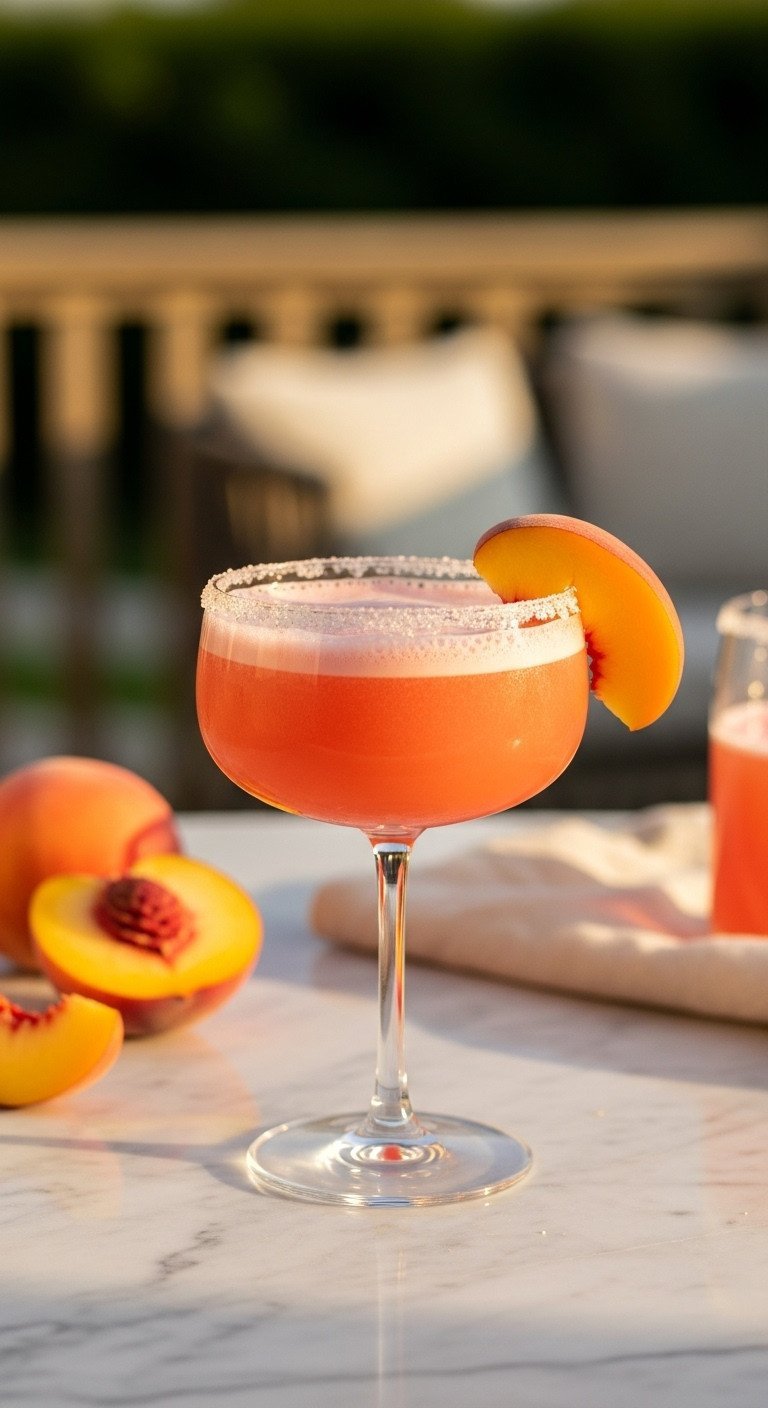
Share this elegant drink idea with your friends!
H4: Materials Needed:
- 1.28 fl oz Pink Lotus Concentrate (for natural pink hue)
- 1.5 fl oz Peach Puree or High-Quality Peach Syrup (for body and flavor)
- 4 fl oz Sparkling White Grape Juice or Club Soda (use juice for extra sweetness, soda for lower sugar)
- Elegant stemware (optional, but recommended for presentation)
- Fine-grained sugar and a lime wedge for rimming
H4: Step-by-Step Directions:
- Prepare the rim of your glass by running a lime wedge around the edge and dipping it into fine-grained sugar.
- Combine the Pink Lotus concentrate and Peach Puree/Syrup in a separate small mixing tin or glass. Stir well.
- Fill the prepared glass with ice.
- Slowly pour the Lotus mixture over the ice.
- Top the drink with the cold Sparkling White Grape Juice or Club Soda, ensuring an effervescent finish.
- Garnish with a thin slice of fresh, ripe peach.
Pro-Tip: If using White Lotus instead of Pink Lotus, add a drop of natural red food coloring to the peach puree before mixing to achieve a soft pink color.
4. Gold Lotus Mango Turmeric Bliss (Functional Boost)
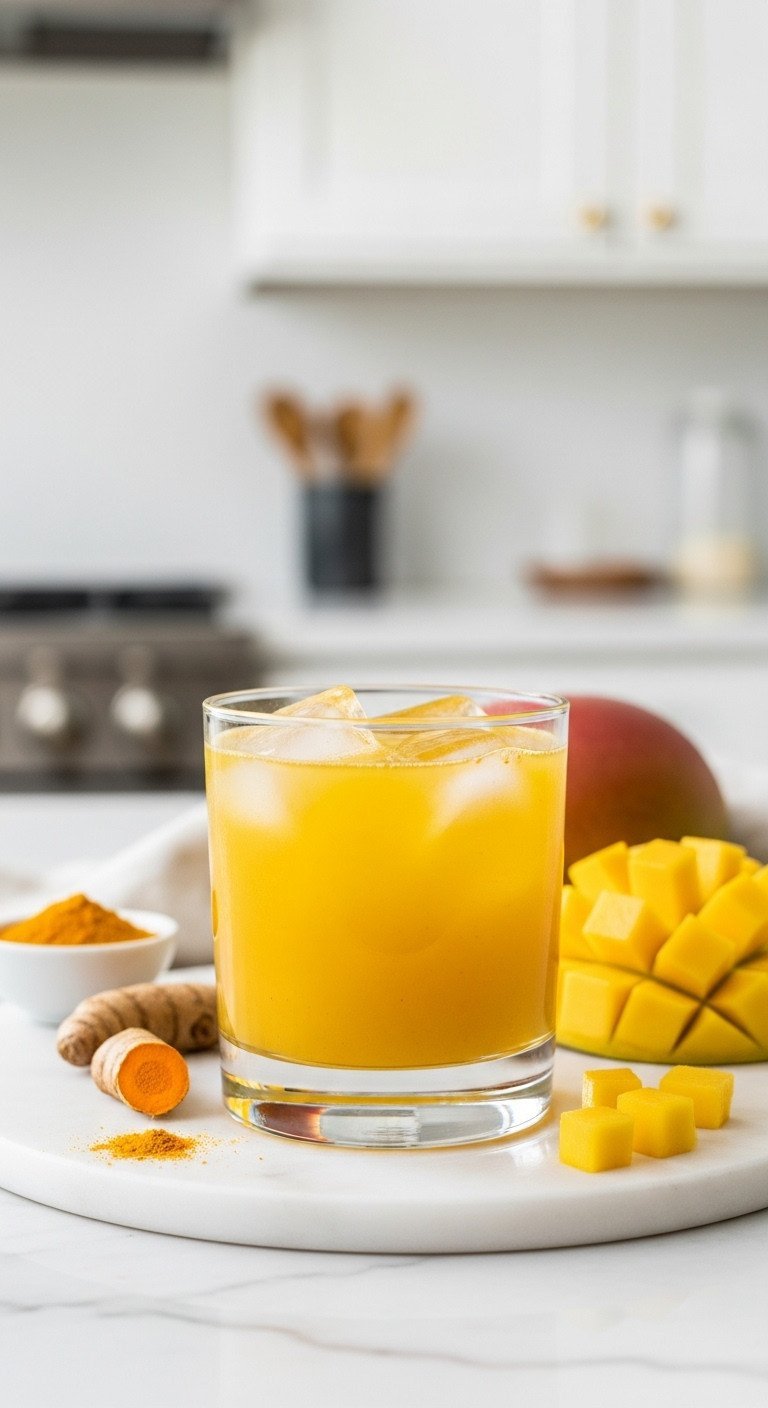
Pin this functional energy recipe now!
H4: Materials Needed:
- 1.28 fl oz Gold Lotus Concentrate (contains the ginger and turmeric notes)
- 1 fl oz Mango Syrup (or puree for a thicker texture)
- 0.25 tsp Freshly Grated Ginger (optional, for an extra zing)
- 5 fl oz Plain Sparkling Water or Club Soda
- Lowball glass and large, clear ice cubes (for slower dilution)
H4: Step-by-Step Directions:
- Combine the Gold Lotus concentrate, Mango Syrup, and fresh ginger (if using) at the base of the lowball glass.
- Stir the mixture well to fully dissolve the syrup and integrate the ginger essence.
- Add the large, clear ice cubes.
- Slowly pour the sparkling water over the ice until the glass is full, respecting the final 5:1 dilution ratio.
- Do not stir after adding the water. Garnish with a thin strip of fresh ginger root or a slice of star fruit.
Lesson Learned: Because Gold Lotus often contains spicy or earthy notes (turmeric, ginger), it pairs best with sweet, simple fruit flavors like mango or pineapple, rather than complex botanicals.
5. Low-Sugar Raspberry Limeade (Diet-Friendly Option)
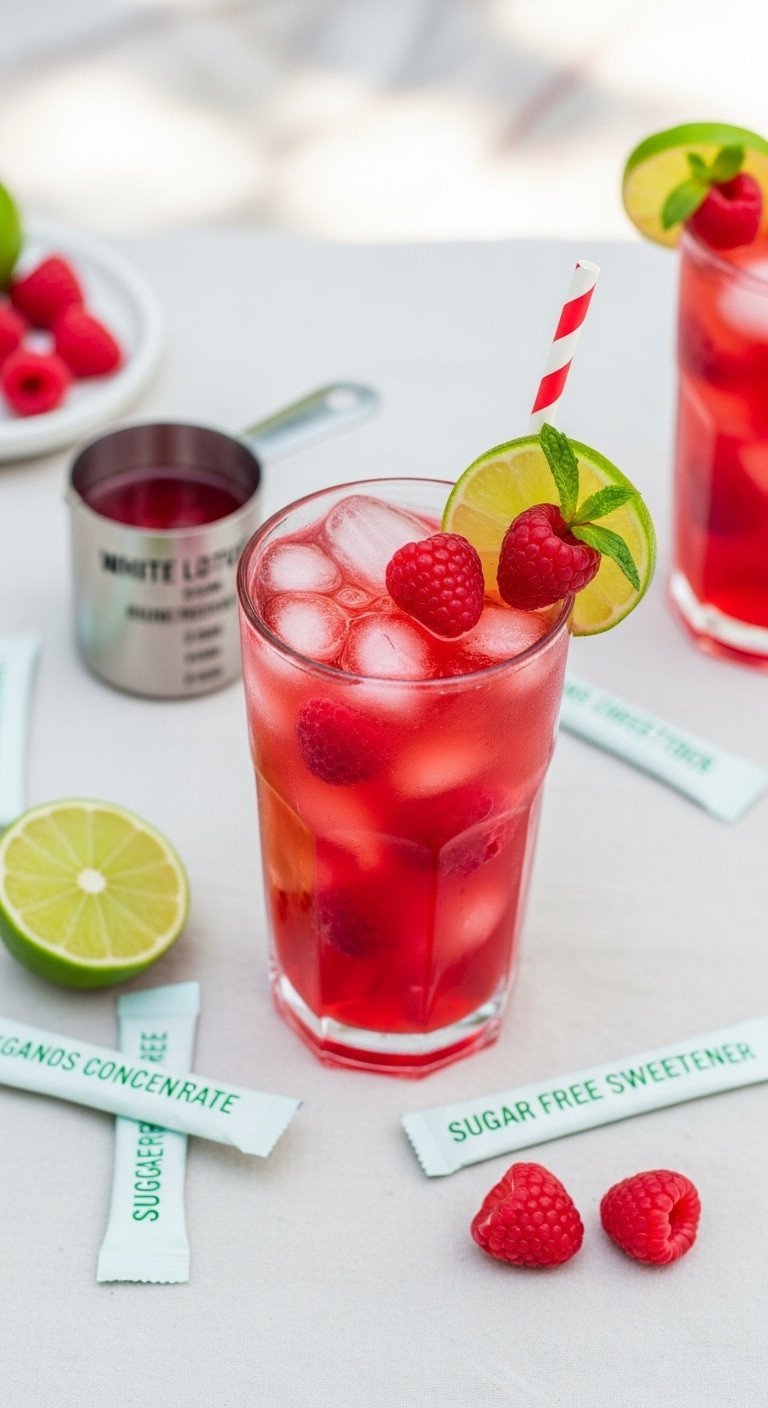
Save this low-carb Lotus recipe!
H4: Materials Needed:
- 1.28 fl oz White Lotus Concentrate (for the energy base)
- 1 fl oz Sugar-Free Raspberry Syrup (ensure high-quality, non-chemical aftertaste)
- 0.5 fl oz Fresh Lime Juice (CRITICAL for balancing the artificial sweetener)
- 4.5 fl oz Club Soda
- Fresh raspberries and lime slices for garnish
H4: Step-by-Step Directions:
- Combine the White Lotus concentrate, Sugar-Free Raspberry Syrup, and fresh lime juice in a shaker cup (without ice). Stir well to ensure optimal flavor blending.
- Fill your serving glass completely with ice.
- Pour the Lotus mixture over the ice.
- Top the drink with cold Club Soda.
- Stir very gently once or twice. Garnish heavily with fresh raspberries and lime wheels to reinforce the natural flavor profile.
Pro-Tip: Using fresh lime juice is essential in low-sugar recipes, as the natural acidity cuts through the artificial sweetness and enhances the fruit flavor, preventing a chemical aftertaste.
6. The Barista’s Secret Triple Berry Blast (Layering Technique)
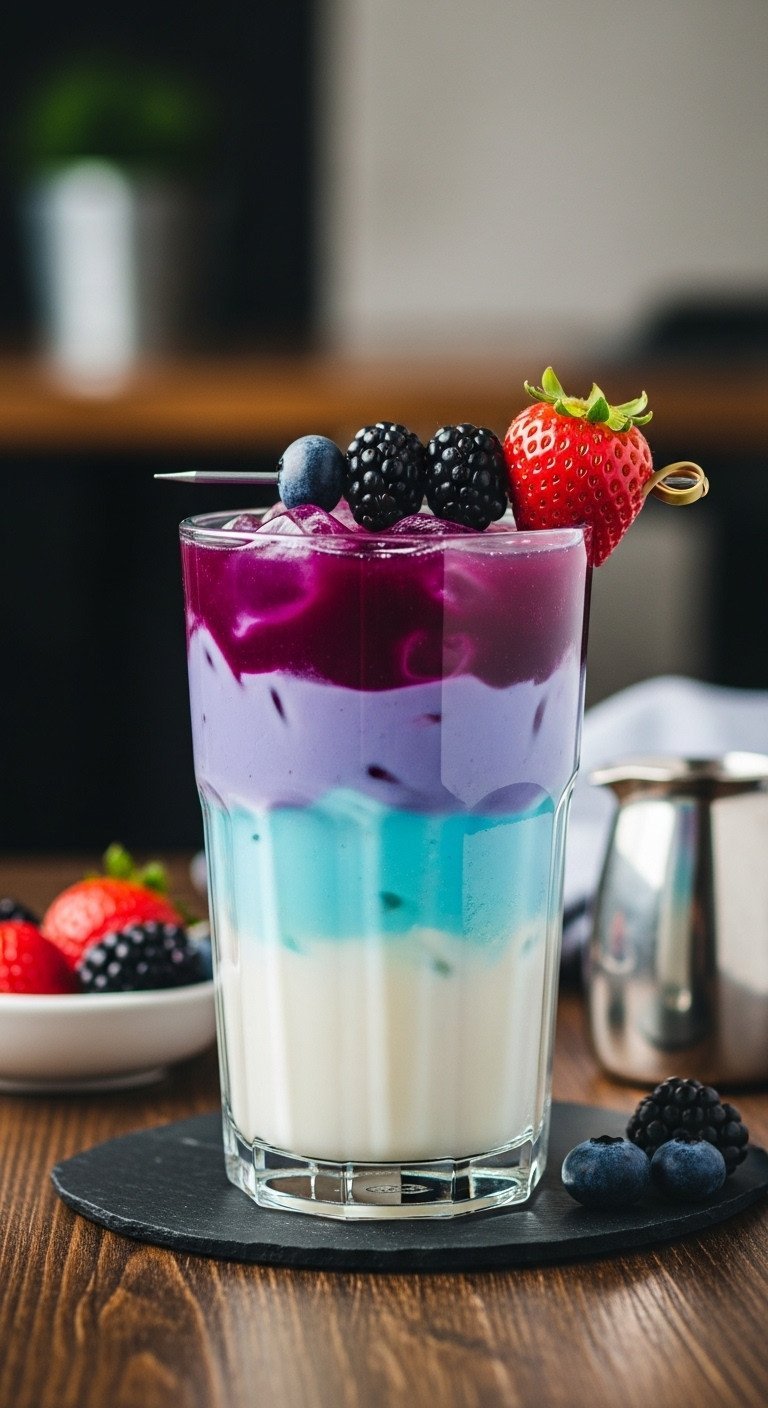
Pin this Pro-Level Mixology Guide!
H4: Materials Needed:
- 0.75 fl oz Blue Lotus Concentrate (the heaviest base layer)
- 0.5 fl oz White Lotus Concentrate (the top layer)
- 0.5 fl oz Blueberry Syrup (heavy base syrup)
- 0.5 fl oz Strawberry Syrup (mid-layer syrup)
- 4.5 fl oz Club Soda
- Clear glass tumbler and a density layering spoon
H4: Step-by-Step Directions:
- Pour the Blueberry Syrup and Blue Lotus concentrate into the bottom of the glass. Do not stir.
- Fill the glass completely with ice, ensuring the ice cubes create a solid surface barrier for the layering.
- In a separate cup, mix the White Lotus concentrate and the Strawberry Syrup.
- Slowly pour the Club Soda over the ice.
- The Layering Step: Hold a density layering spoon (or the back of a small metal spoon) just above the liquid line. Very slowly pour the White Lotus/Strawberry mixture over the back of the spoon, allowing the liquid to run down the sides of the glass and layer on top of the Blue Lotus base.
- Serve immediately without stirring to maintain the visual layers.
Pro-Tip: For the best layering results, keep your base (Blue Lotus) mixture warm and your top mixture (White Lotus) very cold. The colder liquid will be slightly denser and less likely to immediately mix with the base.
7. Red Lotus Holiday Spice Elixir (Seasonal Edition)

Save this seasonal Lotus recipe for the holidays!
H4: Materials Needed:
- 1.28 fl oz Red Lotus Concentrate (ideal for the rich color)
- 1 fl oz Cranberry Juice (pure juice, not cocktail)
- 0.5 fl oz Cinnamon Bark Syrup (or high-quality spice syrup)
- 4.2 fl oz Club Soda or Ginger Ale (use Ginger Ale for extra spice)
- Serving mug, ice, and a muddler
H4: Step-by-Step Directions:
- Muddle a few whole cranberries and a very small slice of orange peel at the bottom of your serving mug to release aromatics. Remove the peel.
- Pour in the Red Lotus concentrate, Cranberry Juice, and Cinnamon Bark Syrup. Stir thoroughly to combine the concentrated flavors.
- Fill the mug with ice.
- Top the mixture with cold Club Soda or Ginger Ale.
- Garnish with a cinnamon stick or a star anise pod.
Lesson Learned: Red Lotus has a strong, deep fruit flavor. If using White Lotus instead, increase the Cranberry Juice and add a drop of natural red color to compensate for the lost pigment.
8. Green Lotus Pineapple Detox (Wellness Focus)
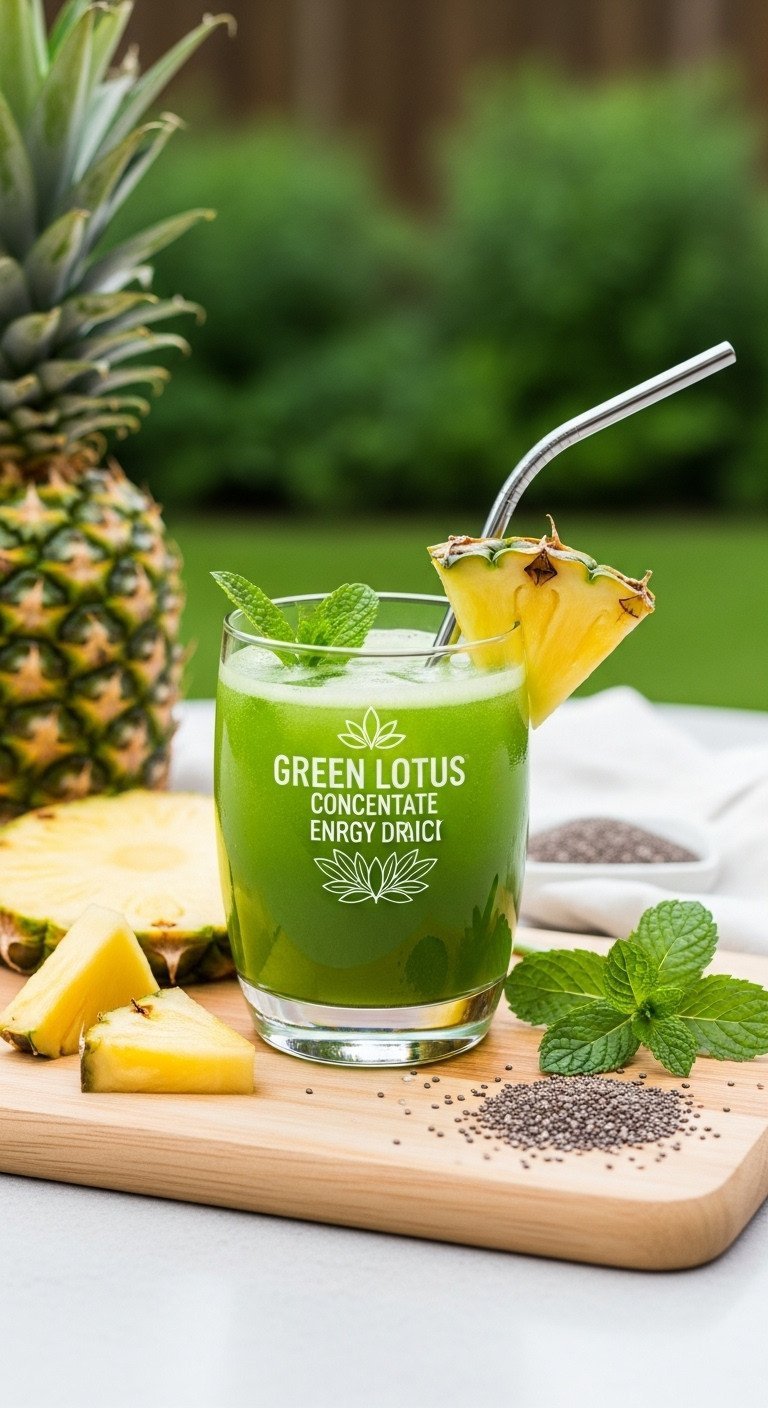
Pin this wellness-focused Lotus mix!
H4: Materials Needed:
- 1.28 fl oz Green Lotus Concentrate (for the rich green hue)
- 1.5 fl oz Pineapple Juice (pure, unsweetened for detox focus)
- 0.5 fl oz Mint Syrup (or 3 fresh mint leaves, muddled)
- 4 fl oz Sparkling Water
- High-quality metal straw and a sturdy muddler (if using fresh mint)
H4: Step-by-Step Directions:
- If using fresh mint, gently muddle the mint leaves at the base of the glass to release the oils. Remove the spent leaves after muddling.
- Combine the Green Lotus concentrate, Pineapple Juice, and Mint Syrup (if using) into the glass. Stir vigorously.
- Fill the glass with ice.
- Top slowly with cold Sparkling Water.
- Garnish with a large sprig of fresh mint and a pineapple wedge.
Pro-Tip: If using White Lotus, you can achieve a similar green color by adding 1 tsp of spirulina powder or a dash of matcha to the mixture, which also enhances the functional profile.
9. Tropical Coconut Cream Dream (Creamy Texture Focus)
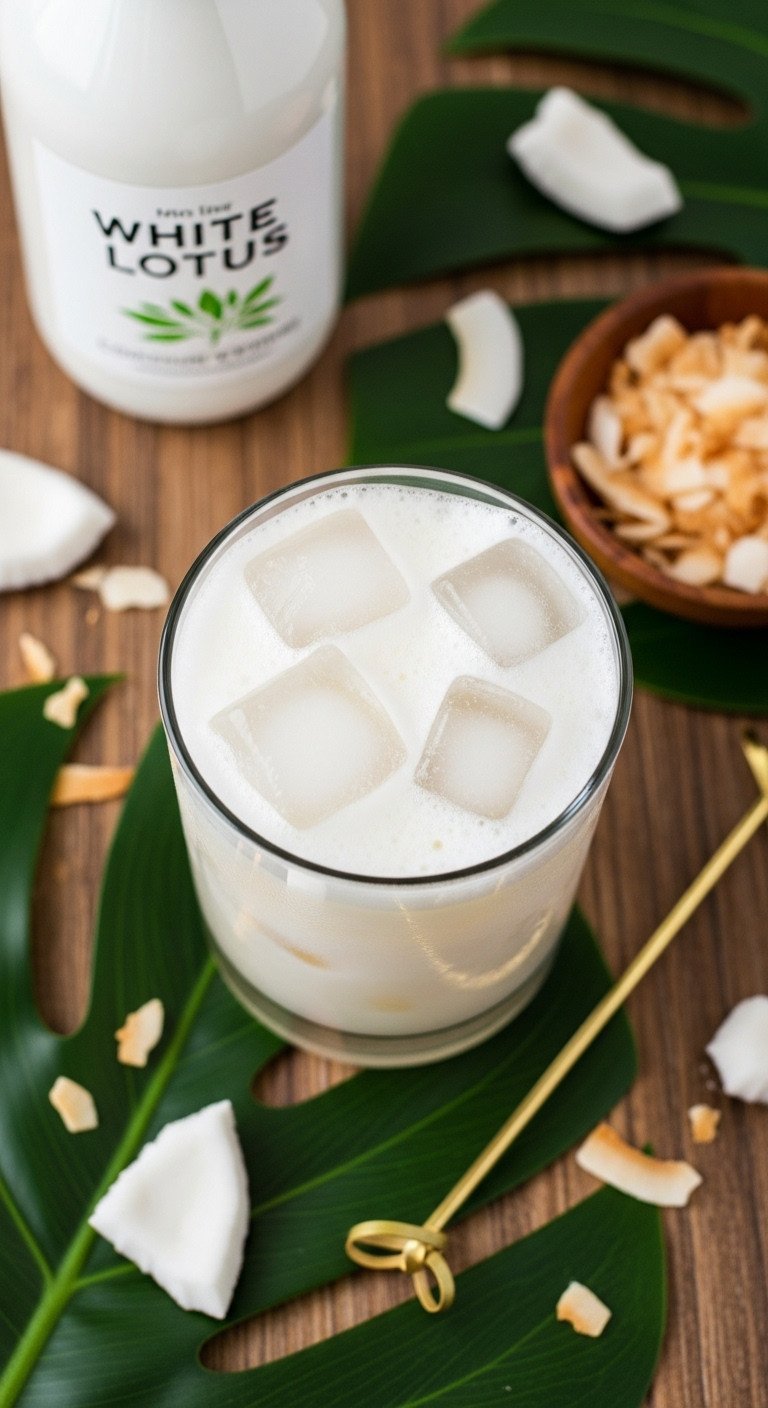
Pin this indulgent coconut recipe for a treat!
H4: Materials Needed:
- 1.28 fl oz White Lotus Concentrate
- 1.5 fl oz Coconut Syrup (or Pineapple Syrup for extra tropical flavor)
- 4 fl oz Club Soda
- 0.5 fl oz Half-and-Half or Heavy Cream (for richness and texture)
- Serving glass and crushed ice
H4: Step-by-Step Directions:
- Combine the White Lotus concentrate and Coconut Syrup in the bottom of the glass. Stir lightly.
- Fill the glass with crushed ice.
- Pour the Club Soda over the ice.
- Measure the Half-and-Half or Heavy Cream into a separate small pitcher.
- Slowly drizzle the cream over the top of the drink. This is known as a “creamy float” and adds visual appeal. Do not stir after adding the cream.
- Garnish with a sprinkle of toasted coconut flakes.
Pro-Tip: For a lighter, vegan-friendly version, substitute the Half-and-Half with 0.5 fl oz of full-fat coconut milk (the canned, thick kind) and mix thoroughly before adding soda.
10. Customizable Decaf Refresher (Family-Friendly Option)

Save this family-friendly decaf idea!
H4: Materials Needed:
- 1.28 fl oz Decaf Lotus Concentrate (ensure it is the caffeine-free base)
- 1 fl oz Syrup of Choice (use natural, non-HFCS fruit flavors like Orange or Grape)
- 5 fl oz Sparkling Grape Juice or Club Soda
- Reusable plastic cups (for young users)
H4: Step-by-Step Directions:
- Choose a syrup flavor based on the user’s preference (e.g., green apple, grape, orange).
- Combine the Decaf Lotus concentrate and the chosen syrup at the bottom of the cup.
- Stir well to dissolve and integrate the flavors.
- Fill the cup with ice.
- Top with the sparkling mixer (using sparkling juice instead of soda can appeal more to children).
- Garnish with the corresponding fruit (e.g., orange slice for orange syrup).
Lesson Learned: Always verify the specific concentrate being used is the certified decaffeinated version if serving to children or those avoiding caffeine. The flavor profiles remain excellent, but the energy benefit is removed.
11. The Black Forest Mocha Fusion (Advanced Coffee Blend)

Pin this Pro-Level Coffee Hybrid Recipe!
H4: Materials Needed:
- 1.28 fl oz White Lotus Concentrate
- 1 fl oz Black Cherry Syrup (or Cherry Bark Syrup)
- 0.5 fl oz Dark Chocolate Syrup
- 3 fl oz High-Quality Cold Brew Coffee (use a concentrated brew)
- 2 fl oz Club Soda (optional, for fizz)
- Serving tumbler and milk frother (for optional foam topping)
H4: Step-by-Step Directions:
- Combine the White Lotus concentrate, Black Cherry Syrup, and Dark Chocolate Syrup in the base of the tumbler. Swirl well.
- Fill the tumbler completely with ice.
- Pour the Cold Brew coffee over the ice slowly.
- (Optional) Top with 2 fl oz of Club Soda for a surprising fizz, or top with a layer of cold foam (milk frothed until thick).
- Garnish with a drizzle of chocolate sauce or a maraschino cherry.
Pro-Tip: This drink contains a very high caffeine load (Lotus 160mg + Cold Brew approx 150-200mg). Advise consumers to treat this as a one-a-day maximum energy solution.
Cost Analysis: Lotus Concentrate vs. Bottled Energy Drinks
One of the most compelling reasons to switch to Lotus is the significant cost efficiency. While the upfront cost of a 64 oz concentrate bottle seems high, the value becomes clear when you calculate the cost per serving. A single bottle yields approximately 50 standard drinks, bringing the price per drink down dramatically compared to buying single-serve, ready-to-drink (RTD) cans.
Based on industry standards, the cost-per-serving for a homemade Lotus drink can be 30-50% lower than popular canned alternatives. For coffee shops, this translates to exceptional profitability, with typical margins on specialty mixed beverages exceeding 60%.
Here’s a quick comparison of what you get with Lotus versus a typical RTD energy drink:
| Feature | Lotus Energy (Homemade) | Typical RTD (e.g., Monster) |
|---|---|---|
| Caffeine Source | Natural (Coffee Fruit) | Often Synthetic |
| Key Ingredients | Adaptogens, B-Vitamins | Taurine, Artificial Flavors |
| Customization | Fully customizable | Fixed flavor and sugar |
| Avg. Cost/Serving | Lower (30-50% less) | Higher |
| Sugar Content | Controllable | High / Fixed |
This analysis highlights that choosing Lotus is not just a health-conscious decision but also a financially savvy one for both home users and commercial businesses.
Key Takeaways: Your Quick Guide to Mastering Lotus Mixology
To make your journey into clean energy a success, keep these five core principles in mind. This is your quick guide to mastering Lotus mixology every time.
- Master the Ratio: The foundational rule for consistency is the 5:1 ratio (1 part concentrate to 5 parts total volume). Use a precise pump (1.28 oz/serving) for accuracy.
- Prioritize Clean Syrups: To maintain Lotus’s “clean energy” profile, pair it with high-quality, natural fruit or botanical syrups, especially if avoiding high-fructose corn syrup.
- Use the Right Base: Use White Lotus for recipes where color is critical or when layering. Use Blue Lotus for the iconic huckleberry flavor and vibrant hue.
- Understand the Kick: Each standard serving delivers 160mg of natural caffeine. Track your intake to ensure sustained, jitter-free energy without overconsumption.
- Don’t Forget the Fizz: Always use cold carbonated water (club soda or sparkling water) to achieve the authentic texture and mouthfeel of a specialty energy drink.
People Also Ask About Lotus Energy Concentrate
Is 160mg of Natural Caffeine in Lotus safer than synthetic alternatives?
The 160mg of natural caffeine in Lotus, derived from coffee fruit, is often perceived as ‘cleaner’ because it co-occurs with antioxidants and beneficial compounds that help modulate the stimulant effect. Many users report a smoother energy boost with fewer jitters and less severe crashing compared to isolated, synthetic caffeine sources found in traditional energy drinks.
How long does an opened bottle of 64 oz Lotus concentrate last?
An opened 64 oz bottle of Lotus concentrate typically remains fresh for 4 to 6 weeks when stored properly in the refrigerator. The natural ingredients require refrigeration once the seal is broken. The bulk size is designed to yield approximately 50 standard servings, ideal for high-volume home users or small commercial settings.
Does Lotus Energy contain artificial sweeteners or high-fructose corn syrup?
Lotus concentrates are specifically formulated without high-fructose corn syrup, artificial colors, or artificial flavors, aligning with the clean label movement. The concentrate itself is sweetened with pure cane sugar. However, the final sugar content of the mixed drink depends entirely on whether the user adds standard or sugar-free flavor syrups.
What is the difference between Blue Lotus and White Lotus bases?
White Lotus is the colorless, neutral base, offering maximum versatility for any flavor combination where the final drink color is determined only by the added syrup. Blue Lotus contains natural blue pigment and a distinct huckleberry infusion, offering a more pre-flavored base profile that pairs best with berry and citrus notes.
Can I mix Lotus Energy Concentrate with plain water instead of club soda?
While technically possible, mixing Lotus concentrate with plain still water is strongly discouraged for optimal flavor and texture. The recommended preparation involves a carbonated mixer (club soda or sparkling water) to provide the necessary effervescence and dilution volume, ensuring the final product tastes like a premium energy drink, not a sugary flat syrup.
Final Thoughts
If you’re ready to move beyond the crash-and-burn cycle of synthetic energy drinks, adopting Lotus concentrates is the best way to take control of your daily energy. By mastering the simple 5:1 ratio and experimenting with these 11 expert recipes, you unlock a world of sustained, customized, plant-powered vitality that is both cleaner for your body and cheaper for your wallet in the long run.
Which of these 11 recipes will you try first to master your clean energy routine in 2025? Share your favorite Lotus flavor combination in the comments below
Last update on 2025-12-05 / Affiliate links / Images from Amazon Product Advertising API

